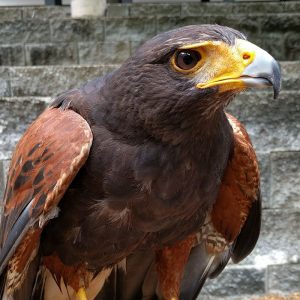American White Pelican – Scoop
Scoop arrived at World Bird Sanctuary through our own Kathryn G. Favre Wildlife Hospital in 2004. He was found in a pond in West Alton with an old shoulder injury, and was having trouble flying and navigating as a whole. After being brought in it was discovered that his injury was great enough that it required a partial amputation. The surgery was successful, however Scoop was left unable to fly. Since he was deemed non-releasable, he was transferred to our education department to become an educational ambassador for his species.
$29.00 – $129.00
Description
HATCH YEAR: UNKNOWN
FUN FACTS ABOUT SCOOP
- While he may be unable to fly, Scoop quickly learned a targeting behavior and began participating in education programs both on and off-site. Watching him excitedly run across our amphitheater stage, wings flapping and large webbed feet slapping, was a highlight for the many years in which he participated in our Birds in Concert series.
- Most of the time though Scoop can be found in his public exhibit with his fellow pelican Mudflap, for whom Scoop has appointed himself the protector of for all things even marginally scary.
- During feeding time, Scoop likes to catch fish in his mouth, to then unceremoniously drop them back on the ground. He loves playing with his food!
SPECIES FACTS
Scientific Name:
- Pelecanus erythorhynchos.
Distribution:
- Northern California, western Nevada, Utah, Colorado, northeastern South Dakota, southwestern Minnesota and occasionally the central coast of Texas; they winter along the Pacific in Central California, south along the Mexican coast to Guatemala and Nicaragua; also along the shores of the Gulf of Mexico; occasionally found along the Mississippi River.
Habitat:
- Brackish and freshwater lakes, salt bays, marshes, beaches and rivers.
Diet:
- More than 4 pounds of fish per day; American white pelicans do not dive to catch prey – it simply floats along the water and scoops up fish with its enormous bill; the bill can hold 3 gallons of water; after fish are caught, the bill is pointed downward allowing the water to drain out; often fish in groups.
Behavior:
- They nest in colonies of several hundred pairs on islands in remote lakes of inland North America; female lays 2-3 chalky white eggs in a shallow depression on the ground; both parents incubate and feed the young by regurgitation; young are dependent for about 5 months.
- Adults rarely make any noise, but when they do it is usually a low grunt.
Identification:
- Adults – white with black primaries and outer secondaries; yellowish pouch connected to the lower mandible that stretches up to six inches; webbed feet are bright orange; legs are orange and extremely short; Immature – mostly white wing coverts mottled head and neck grayish; Juvenile – dusky overall.
- Males and females are indistinguishable except during breeding season when the male develops a fibrous plate on the upper part of the beak, the crest becomes bright yellow, and the bill becomes bright orange; the “horn” is shed after the eggs are laid.
Additional information
| Adoption Level | Fan, Friend, Sponsor |
|---|
Related products
-

Bald Eagle – Clark
$29.00 – $129.00 Select options This product has multiple variants. The options may be chosen on the product page -

Harris’s Hawk – Blue
$29.00 – $129.00 Select options This product has multiple variants. The options may be chosen on the product page




